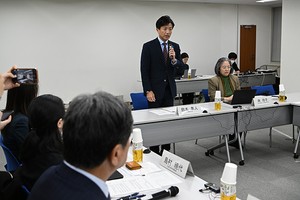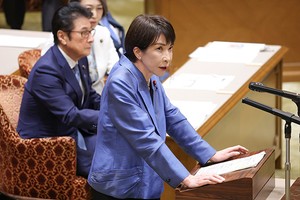THE ASAHI SHIMBUN
January 29, 2025 at 18:10 JST
YASHIO, Saitama Prefecture--Rescue workers on Jan. 29 were trying to retrieve the driver of a 2-ton truck that fell into a sinkhole at a prefectural road intersection here.
The sinkhole is about 10 meters in diameter and 10 meters deep, and water likely from a broken sewer pipe was seeping in, according to the Soka Police Station of the Saitama prefectural police.
The sinkhole developed at 9:50 a.m. on Jan. 28, causing the road to collapse in the Yashio 2-chome district.
During the rescue operation, another cave-in occurred near the original site at 1:10 a.m. on Jan. 29, while a crane was being used to pull out the truck.
Concerned about dangers from a gas pipe running underground in the area, police have called on residents within a 200-meter radius to evacuate.
According to an official, Yashio city opened an evacuation center in a municipal government building, and about 150 residents have sought shelter there.
The truck bed was pulled out before dawn on Jan. 29, but the driver remained in the sinkhole, with his condition unknown.
He was initially able to talk, but he did not respond when firefighters called out to him in the evening, according to the fire department.
A 4.75-meter diameter sewage pipe runs about 10.6 meters deep at the accident site, the Saitama prefectural government said.
The sinkhole “probably happened because the sewer pipe burst,” Saitama Governor Motohiro Ono said on Jan. 28.
On the morning of Jan. 29, water was accumulating in the sinkhole, and the driver’s seat of the truck was submerged.
The fire department was forced to halt the rescue operation to drain the water.
The prefectural government used a drone to check the hollow part inside the sinkhole and radar to examine the underground conditions as a safety measure, while vacuum trucks removed water from the hole.
The rescue operation restarted around 4 p.m. after workers on a ladder truck checked the water level and determined it was low enough.
The accident likely blocked other sewage pipes, and the prefectural government notified 12 cities and towns in the eastern part of the prefecture to restrict the use of sewage systems on the morning of Jan. 29.
An estimated 1.2 million people have been affected.
In fiscal 2021, a visual inspection confirmed corrosion in some parts of the pipe, but it was determined that repairs were not necessary.
The prefectural government’s sewage operation division believes the water flow became restricted in the corroded pipe, and sulfuric acid generated by the decay of organic substances in the sewage caused the pipe to burst.
The site is 1.3 kilometers north of Yashio Station, a stop on the Tsukuba Express Line.
(This article was written by Shun Tsunekawa and Masahide Miyajima.)




















A peek through the music industry’s curtain at the producers who harnessed social media to help their idols go global.
A series based on diplomatic documents declassified by Japan’s Foreign Ministry
Here is a collection of first-hand accounts by “hibakusha” atomic bomb survivors.
Cooking experts, chefs and others involved in the field of food introduce their special recipes intertwined with their paths in life.
A series about Japanese-Americans and their memories of World War II